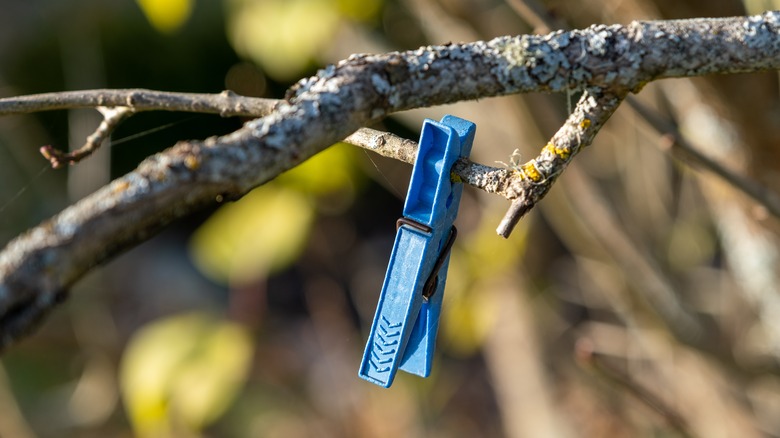Garden Edible Gardening
Kate Nicholson
On healthy fruit trees, branches reaching for the sky focus on girth and leaf growth, whereas horizontal branches produce more fruit earlier. Saplings less than a year old are small with few branches, all about the same width and strength. You need to help your future fruit tree decide which branch will become its supportive main trunk or central leader and which will bear the fruit. You can prune your trees, of course, though a less invasive option is to use branch spreaders. Spreaders can be made of wire, small pieces of wood, or even toothpicks (for very thin branches). However, clothespins are arguably the easiest, cheapest, and most accessible option.
Attaching clothespins onto first-season sapling branches to train them to grow downward instead of up toward the sky is one of the best ways to help your fruit trees thrive. The peg tells the tree that the clipped branches are just that, branches — not the main trunk. It’s a useful option for all fruit tree saplings and standard practice in the fruit-growing industry. Home gardeners will find it especially helpful for young trees that can’t easily be pruned, such as multi-grafted fruit trees. Any clothespins will do, so long as they’re the spring-loaded kind. The old-fashioned “wooden doll” type pegs won’t work for this purpose since they’re not flexible enough.
The how-to

Sandris Veveris/Shutterstock
Wooden pegs are the most eco-friendly option — if crafted from raw, untreated wood, they’re biodegradable. Amazon has a 50-pack of 2.9-inch wooden clothespins for $5.49. If you’re looking for something that lasts, consider plastic clothespins, like this 50-pack of Honey Can Do brand pegs for $11.20 from Walmart. Bonus: Colorful plastic clothespins help you see which branches you’ve bent and which still need to be done. The wooden ones tend to camouflage.
Clip the “clip” end of the peg onto the branch you want growing horizontally. The peg should be facing upward from the branch, not downward. Very gently push the branch downward, peg attached, until you can slip the other end of the peg onto the central leader. Aim for a branch angle between 45 and 90 degrees from the trunk. If the trunk is still thin, you can switch the peg around, clipping it to the trunk rather than the branch. Since you’re dealing with a young tree, all the branches should be quite supple; that doesn’t mean they can’t break, though, so adjust the angle slowly. If you’re trying to train older branches, clothespins come in handy, too. Clip one end of the peg to the branch and another to a small cement weight hanging downward. Remove the clothespins two to three weeks after you attach them or at the end of the first season — depending on how well-trained the branches look.



